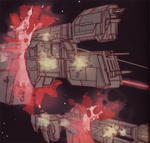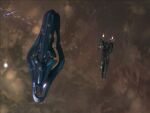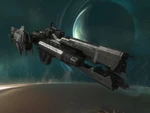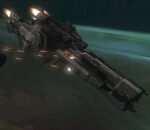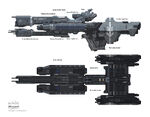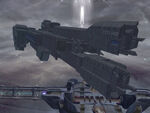| This article may not meet Halo Alpha's standards. You can help by cleaning this article. |
The UNSC frigate is a warship classification in the UNSC Navy. Although it significantly lacks armor and firepower compared to its larger cousin, the destroyer, the frigate is smaller and thus more maneuverable. It is cheaper to produce, allowing greater numbers to be fielded against the Covenant.
Background
With current human technology, frigates are barely considered a match for even the smallest of Covenant warships. It is outclassed even by smaller Covenant ships, its armor is susceptible to enemy point-defense pulse lasers and plasma torpedos, and it is outfitted with substandard weaponry. Only en masse does the UNSC frigate give any UNSC fleet element an advantage against even a small number of Covenant Capital Ships. Despite this, two frigates, the Template:UNSCship and the Template:UNSCship played a crucial role in winning the Human-Covenant war, acting as the human flagships in the Battle of Installation 05 and the Battle of Installation 00, although both ended up being destroyed, with the In Amber Clad crashing into High Charity and Forward Unto Dawn being caught in The Portal while escaping the replacement for Installation 04.
Layout
The Bridge of the frigate is located in the uppermost part of the ship, in the section at the stern-most tip of the MAC gun shaft (in the case of the only seen version of the UNSC frigate, there is another layout variation similar in appearance to the Halcyon-class light cruiser, UNSC Pillar of Autumn. The commanding officer's chair is located behind the two primary consoles within the bridge. There are numerous other consoles located at the sides of the room. There are four bridge stations: Navigation, Operations, Weapons, and Communications.
A UNSC frigate also possess 12 SOEIV bays, located in the rear of the ship, which facilitate the deployment of Orbital Drop Shock Troopers.
UNSC frigates are capable of hovering in an atmosphere and even landing. This ability is displayed by both the UNSC Grafton and the UNSC Saratoga in Halo: Reach and the UNSC Forward Unto Dawn in Halo 3. They also have either a garage or cargo bay in their rear section which is capable of extending out of the ship's ventral side to deploy vehicles or cargo directly to the ground.[5][6] The UNSC Forward Unto Dawn carried multiple Pelican dropships in this rear section in addition to several ground vehicles.
The UNSC frigates are small compared to assault carriers of the Covenant and can fit in the hangar of one, like in Halo 3 with UNSC Forward Unto Dawn and the Shadow of Intent.
Variants
There are multiple different variants of the UNSC frigate. Each of these variants, designed for different actions, are armed with various weapons and have different dimensions.
- The Charon-class light frigate has a large complement of dropships, ground forces, and ground vehicles. It is not as heavily armed or armored as other escort vessels of similar design. This implies a role as fleet support and troop carrier, although it is still capable of ship-to-ship combat.
- The Paris-class heavy frigate boasts additional Titanium-A armor plating and a larger number of point-defense guns than standard frigates. Another major difference that has been observed between light UNSC frigates and heavy frigates is the size of the main hangar on the underside of the vessel.
- The Stalwart-class light frigate is best suited for planetary defense, fleet escort duties, and troop deployment. It has a smaller complement of vehicles than the Charon class, and less armament than the Paris class, effectively balancing it between troop transportation and fleet support.
- Light frigates of the same class as the UNSC Midsummer Night fill similar roles to a prowler's. They are used primarily on information gathering missions and for covert ops. It is presumably not as combat capable as the other frigate variants. It may be synonymous with one of the above light frigates.
Specifications
Dimensions

UNSC Frigate variant scale comparison
Three frigate classes are of identifiable proportions. The largest, the Paris-class, is 535 metres (1,760 ft) long, while the smallest, the Stalwart-class, is 478 metres (1,570 ft) long. The Charon-class reaches 490 metres (1,600 ft) long. The heights of all three are the same, all reaching 112.3 metres (368 ft).
Propulsion
Like other human ships, the UNSC frigate is powered by thermonuclear fusion reactors which use deuterium (a stable hydrogen isotope) as fuel. The engines almost certainly use the energy obtained from this process to heat some form of reaction propellant which is expelled out of rear-facing exhausts to generate thrust. There are four exhausts visible on frigates; two large and two small.
For translight voyages, the frigate carries a Shaw-Fujikawa Translight Engine. Although they cannot be seen, it can be safely assumed that frigates also possess multiple maneuvering thrusters to adjust a vessel's attitude in three dimensions. Finally, frigates have several times been observed to hover in an atmosphere. It is possible that they vector thrust downward in order to accomplish this feat, but no downward-pointing exhaust nozzles are visible. It is also possible that they employ some form of Covenant-derived antigravity mechanism, or perhaps electrostatic or magnetic levitation, although it is unlikely due to the use of frigates prior to the war.
Armament
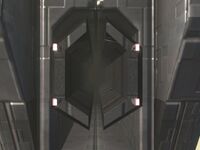
The MAC barrel on a UNSC frigate.
A typical UNSC frigate carries the following armament:
- 1 Magnetic Accelerator Cannon which is able to fire one round per charge. The MAC runs between one- and two-thirds of a frigate's total length.
- 3 Shiva-class Nuclear Missiles serves as heavy ordinance.
- 40 Archer missile pods which carry around thirty missiles per pod, adding up to a total of 1200 missiles.
- 12 50mm point defense guns function as the last line of defense against single ships and incoming missiles.
Crew
No precise figures are available regarding the crew of a frigate, but it is likely relatively small, (less than a hundred would be stationed on a frigate). Like larger ships, a detachment of Marines and sometimes ODSTs would be present on board. The crew number includes deck crews as well as the command crew, Marines, ODSTs, dropship pilots, and technical personnel. The number of personnel a single frigate is capable of housing numbers at least within the thousands.[7][verification needed] Frigates have 24 three man escape pods on each side, and 32 on the bottom, making 80 in total. Therefore, 240 personnel can escape via this method.
In 2552, Sergeant Major Avery Johnson was supposedly able to single handedly control the frigate Template:UNSCship to aid John-117, Cortana and Thel 'Vadam on the newly rebuilt Halo, though this was likely performed using an auto-pilot function. Similarly, Thel seemed to be able to pilot the Dawn at least somewhat after Cortana activated its engines and was removed from the systems, but in that case all he really had to do was point the ship at the Portal and fly into it which was likely a relatively simple task. An AI can monitor and regulate all critical functions without human intervention. Also, the Template:UNSCship was able to be staffed by only a small amount of crew, survivors of the Fall of Reach and the Battle of Installation 04 although in that case, Cortana was on board and was undoubtedly able to do much of the work.
Superstructure

A frigate from the side.
The armor of a frigate is relatively poor compared to that of its larger cousins and counterparts such as the destroyer, with only 60 cm of Titanium-A battle plate. However, due to its relatively light weight, the frigate's strength lies instead in maneuverability and speed. The frigate's relatively wide design is supported by structural support ribs, allowing it to perform orbital incursions.[4] Furthermore, these ships also have external hard points on thier hulls so that they can be towed by another ship or tow away another damaged ship.
Known frigates
| ||||||||||||||||||||
Changes from Halo 3 to Halo: Reach
- The frigate's hangar is about the width of a Sabre in its Halo: Reach rendition, approximately half the size of its Halo 3 version.
- The frigate's hangar is also much longer in its Halo: Reach version.
- The frigates in Halo 3 have only four point defense turrets while in Halo: Reach they have twelve. This is because the Halo: Reach versions are Paris - Class heavy frigates and would naturally have more armaments. While those in Halo 3 are just Charon - Class light frigates which is meant for support.
- The frigate's MAC gun is hexagonal in Halo 3, whereas in Halo: Reach the MAC gun is circular, but it still maintains the grooves at the top and bottom.
Trivia
- In Halo: Reach, frigates share similarities with Halo 2 frigates when comparing Hangar sizes.
- From Halo 2 to Halo: Reach, the frigates have a noticeable difference. The frigates in Halo 2 seem to have a bigger "bump" on the front of the frigate, near the MAC gun.
- In Halo 3, it is possible for the frigate to release its hangar bay doors.
Gallery
A UNSC frigate picking up survivors from Algolis. As shown here, Longsword fighters are not too large to be carried by frigates. A preview of UNSC frigate lowering its cargo bay for the insertion of ground forces and vehicles onto the battlefield. A preview of a UNSC frigate firing a round from its Magnetic Accelerator Cannon. UNSC In Amber Clad compared to the Prophet of Regret's Assault Carrier. A UNSC frigate, the UNSC Commonwealth, being taken apart, partially showing the ship's internal structure. A destroyed UNSC frigate over Reach from Halo: Reach Announcement Trailer, likely the UNSC Savannah destroyed by the Covenant Corvette Ardent Prayer. A YSS-1000 "Sabre"-class starfighter and the Template:UNSCship engaging a SDV-class heavy corvette over Reach. A UNSC frigate facing a SDV-class heavy corvette. The UNSC Savannah above Reach. The UNSC Savannah engaging a SDV-class heavy corvette. The UNSC Savannah, docked with Anchor 9. A size comparison A frigate fends off a SDV-class heavy corvette. 5 UNSC frigates orbiting an unknown planet UNSC Forward Unto Dawn landing on the Ark. The Forward unto Dawn falling towards a Forerunner planet The UNSC In Amber Clad with emblem Several scrapped frigates in the Aszod ship breaking yards. |
List of appearances
Sources
- ↑ Halo Encyclopedia, page 248
- ↑ 2.0 2.1 2.2 2.3 2.4 2.5 Halo: The Essential Visual Guide, page 76
- ↑ Halo: The Fall of Reach, page 111
- ↑ 4.0 4.1 The Art of Halo 3
- ↑ Halo 2
- ↑ Halo 3, level The Ark
- ↑ Halo: First Strike, page ??
External
| ||||||||||||||||||||||||||




